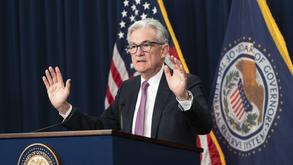 Traders work during the opening bell at the New York Stock Exchange on Aug 16, 2022 at Wall Street in New York City.
(ANGELA WEISS / AFP)
Traders work during the opening bell at the New York Stock Exchange on Aug 16, 2022 at Wall Street in New York City.
(ANGELA WEISS / AFP)
Wall Street ended Friday with all three benchmarks more than 3 percent lower, as Federal Reserve Chief Jerome Powell's signal that the central bank would keep hiking rates to tame inflation nixed nascent hopes for a more modest path among some investors.
The Nasdaq led declines among the three US benchmarks, registering its worst daily performance since June 16, weighed by high-growth technology stocks which tumbled after rallying the previous day in anticipation of Powell's scheduled speech to the Jackson Hole central banking conference in Wyoming.
The US economy will need tight monetary policy "for some time" before inflation is under control, said Federal Reserve Chief Jerome Powell
The US economy will need tight monetary policy "for some time" before inflation is under control, Powell said at the event. That means slower growth, a weaker job market and "some pain" for households and businesses, he added.
READ MORE: US inflation: Fed jacks rates again, Powell vows no surrender
Investors knew further rate rises were coming, and they have been divided between whether a 75-basis-point and a 50-basis-point hike by the Fed was coming next month.
However, recent data highlighting continued strength in the labor market, to offset two consecutive quarters of negative economic growth, had led to some speculating a more tempered pace of hikes could be forthcoming.
"The pushback is coming from the idea that it's not about the pace of hikes going forward and how they tighten financial conditions, it's about the duration of remaining at that restrictive policy stance," said Garrett Melson, portfolio strategist at Natixis Investment Managers.
"That's the nuance they are trying to push forward and Powell was, maybe, a bit more explicit in that today. But if you've listened to other Fed speakers in the last couple of weeks, it's the same message."
With investors repositioning after absorbing the speech, the Cboe Volatility Index jumped 3.78 points to 25.56, its highest close in six weeks.
All the 11 major S&P 500 sectors were lower, led by declines of between 3.9 percent and 4.3 percent in the information technology, communication services and consumer discretionary indexes.
 Federal Reserve Chairman Jerome Powell speaks during a news conference at the Federal Reserve Board building in Washington, July 27, 2022. (MANUEL BALCE CENETA / AP)
Federal Reserve Chairman Jerome Powell speaks during a news conference at the Federal Reserve Board building in Washington, July 27, 2022. (MANUEL BALCE CENETA / AP)
The S&P 500 lost 141.46 points, or 3.37 percent, to end at 4,057.66 points, while the Nasdaq Composite lost 497.56 points, or 3.94 percent, to 12,141.71. The Dow Jones Industrial Average fell 1,008.38 points, or 3.03 percent, to 32,283.40.
High-growth and technology stocks dropped. Nvidia Corp and Amazon.com Inc fell 9.2 percent and 4.8 percent, respectively, having led gainers in the previous session. Meanwhile, Google-parent Alphabet Inc, Meta Platforms Inc , and Block Inc also dipped between 4.1 percent and 7.7 percent.
Friday's falls wiped out the modest August gains which all three benchmarks had previously carved out, and sent the trio to their second straight week of declines. For the week, the Nasdaq slid 4.4%, the Dow lost 4.2%, and the S&P 500 fell 4%
US stock indexes have retreated since the turn of the year as investors priced in the expectation of aggressive interest rate hikes and a slowing economy.
ALSO READ: Fed minutes show more rate hikes, but pace could slow
But they have recovered strongly since June, with the S&P 500 recouping nearly half its losses for the year on stronger-than-expected quarterly earnings and hopes decades-high inflation has peaked.
However, Friday's falls wiped out the modest August gains which all three benchmarks had previously carved out, and sent the trio to their second straight week of declines.
For the week, the Nasdaq slid 4.4 percent, the Dow lost 4.2 percent, and the S&P 500 fell 4 percent.
Data earlier showed consumer spending barely rose in July, but inflation eased considerably, which could give the Fed room to trim its aggressive interest rate increases.
Dell Technologies Inc fell 13.5 percent as it joined rivals in predicting a slowdown as inflation and the darkening economic outlook prompt consumers and businesses to tighten their purse strings.
Affirm Holdings Inc tumbled 21.3 percent after the buy-now-pay-later lender forecast full-year revenue below Wall Street estimates, underscoring the broader downturn in the fortunes of the once high-flying fintech sector.
Volume on US exchanges was 10.37 billion shares, compared with the 10.64 billion average for the full session over the last 20 trading days.


